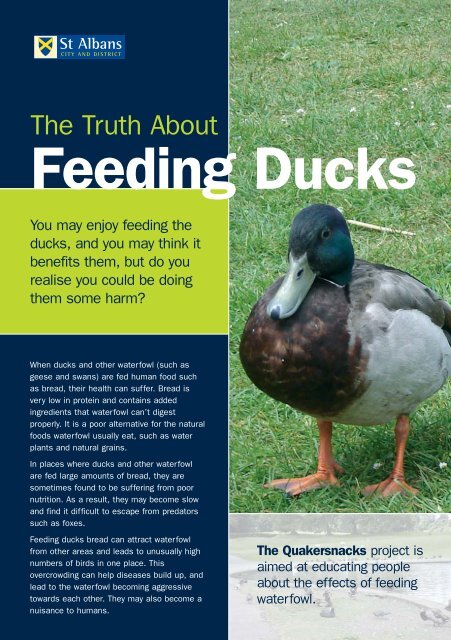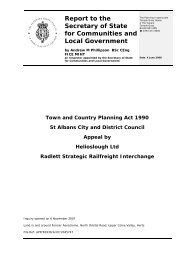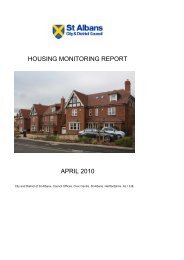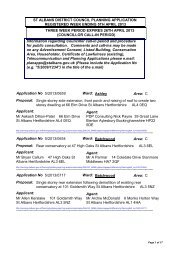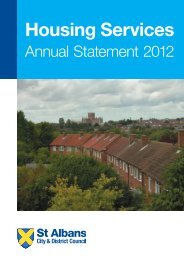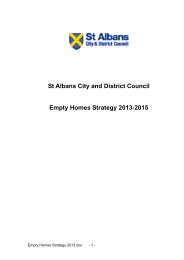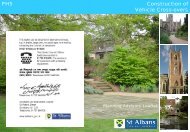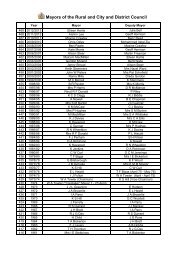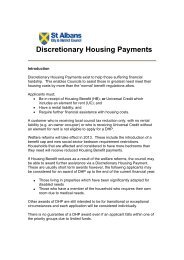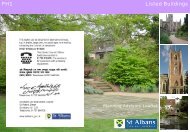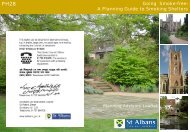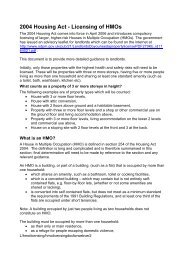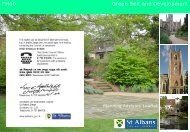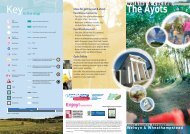Quackersnacks Leaflet - St Albans City & District Council
Quackersnacks Leaflet - St Albans City & District Council
Quackersnacks Leaflet - St Albans City & District Council
You also want an ePaper? Increase the reach of your titles
YUMPU automatically turns print PDFs into web optimized ePapers that Google loves.
The Truth About<br />
Feeding Ducks<br />
You may enjoy feeding the<br />
ducks, and you may think it<br />
benefits them, but do you<br />
realise you could be doing<br />
them some harm?<br />
When ducks and other waterfowl (such as<br />
geese and swans) are fed human food such<br />
as bread, their health can suffer. Bread is<br />
very low in protein and contains added<br />
ingredients that waterfowl can’t digest<br />
properly. It is a poor alternative for the natural<br />
foods waterfowl usually eat, such as water<br />
plants and natural grains.<br />
In places where ducks and other waterfowl<br />
are fed large amounts of bread, they are<br />
sometimes found to be suffering from poor<br />
nutrition. As a result, they may become slow<br />
and find it difficult to escape from predators<br />
such as foxes.<br />
Feeding ducks bread can attract waterfowl<br />
from other areas and leads to unusually high<br />
numbers of birds in one place. This<br />
overcrowding can help diseases build up, and<br />
lead to the waterfowl becoming aggressive<br />
towards each other. They may also become a<br />
nuisance to humans.<br />
The Quakersnacks project is<br />
aimed at educating people<br />
about the effects of feeding<br />
waterfowl.
Your Health<br />
What you can do to help<br />
Bread thrown into the lake or onto the banks<br />
can cause problems for waterfowl, fish and the<br />
environment.<br />
When bread rots in the water, it creates perfect<br />
conditions for algae (a plant which grows in the<br />
water) to grow. The algae uses up the oxygen<br />
which fish need to survive, and large amounts<br />
of algae can make the water smell unpleasant.<br />
Certain types of algae can make the water<br />
poisonous to pets if they drink it.<br />
Bread which is left behind can attract pests<br />
such as rats and foxes. Waterfowl and rats will<br />
leave droppings where they feed, so bread left<br />
at the edge of the water will create an unhealthy<br />
environment for people who visit the lake.<br />
Many people have fond memories from<br />
childhood of feeding the ducks. So, instead of<br />
telling people not to feed the local wildlife at<br />
all, we are encouraging people to use ‘healthy<br />
snacks’ of grain rather than bread. You can get<br />
bags of grain from the Inn on the Park or the<br />
ice cream seller for a small fee.<br />
We recommend that you should only feed the<br />
waterfowl at specific feeding sites shown by<br />
the ‘<strong>Quackersnacks</strong>’ signs. This will reduce<br />
the amount of time and money we spend on<br />
cleaning up the area to make it safe and<br />
pleasant for all visitors. Birds which have a<br />
more natural, healthier diet can expect to live<br />
a longer, happier life.<br />
Thank You<br />
This leaflet can be obtained in alternative<br />
formats, eg. in braille, large print, on audio<br />
tape, or email by contacting the council on<br />
01727 819366


